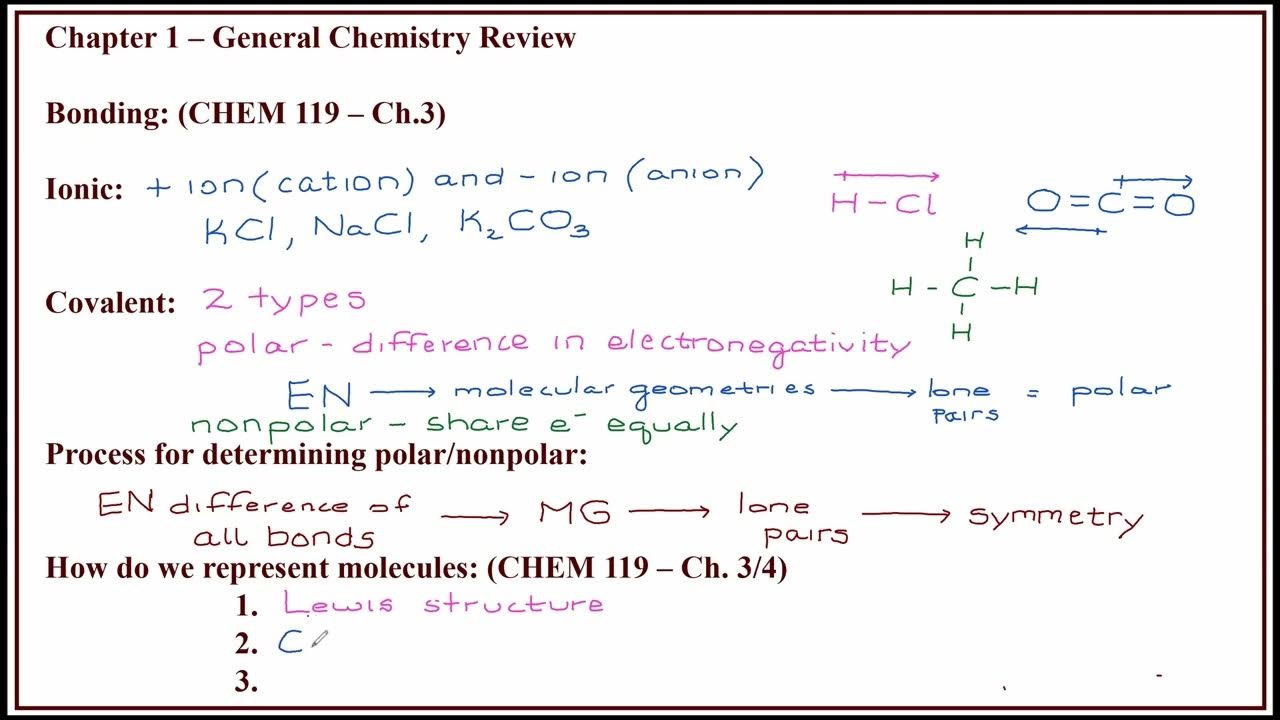Formal charge | Molecular and ionic compound structure and properties | AP Chemistry | Khan Academy
Summary
TLDRThis chemistry lesson introduces the concept of formal charge, a tool for analyzing molecular structures. The instructor explains how to calculate the formal charge for individual atoms by comparing valence electrons in a free atom to those allocated in a molecule. Using nitrous acid as an example, the video demonstrates how formal charge can help determine which resonance structures contribute more to a molecule's resonance hybrid, highlighting the importance of this concept in understanding molecular configurations.
Takeaways
- 🔍 The concept of formal charge is introduced as a tool for chemists to analyze molecules, focusing on individual atoms rather than the molecule's overall charge.
- 📚 Formal charge is calculated for each atom by considering the number of valence electrons in a free, neutral atom and subtracting the number allocated to the bonded atom.
- 📉 To determine the number of valence electrons allocated, count the lone pair electrons and add half the number of shared electrons in bonds.
- 🌐 The script uses nitrous acid as an example to illustrate the calculation of formal charge on different atoms within its resonance structures.
- 🔑 The formal charge calculation helps in understanding which resonance structures contribute more significantly to a molecule's resonance hybrid.
- 👉 For hydrogen in nitrous acid, the formal charge is zero as it has one valence electron both in a free state and when bonded.
- ⚠️ Oxygen in one configuration of nitrous acid has a formal charge of +1, indicating one more valence electron than a free, neutral oxygen.
- 🔄 Nitrogen in the molecule has a formal charge of zero, with five valence electrons allocated similarly to its free state.
- 🔻 Another oxygen in the molecule has a formal charge of -1, suggesting one less valence electron than a free, neutral oxygen.
- 🆚 The first resonance structure of nitrous acid has formal charges of +1 and -1 on different oxygen atoms, while the second structure has all atoms with a formal charge of zero.
- 📈 Structures with individual atom formal charges closer to zero are more likely to contribute to the resonance hybrid, a point to be further discussed in future videos.
Q & A
What is the main purpose of calculating formal charge in chemistry?
-The main purpose of calculating formal charge is to analyze molecules and determine which resonance structures or configurations contribute most to a resonance hybrid.
How is formal charge different from the actual charge on a molecule?
-Formal charge is a calculated number for each individual atom in a molecule, whereas the actual charge refers to the charge on the molecule as a whole.
What is the definition of formal charge according to the script?
-The formal charge of an atom is calculated by taking the number of valence electrons in a free, neutral atom and subtracting the number of valence electrons allocated to the bonded atom, which includes lone pair electrons plus half the number of shared electrons.
How many valence electrons does a free, neutral hydrogen atom have?
-A free, neutral hydrogen atom has one valence electron.
How do you calculate the number of valence electrons allocated to a bonded atom?
-The number of valence electrons allocated to a bonded atom is the sum of the lone pair electrons and one half of the number of shared electrons in the bonds connected to the atom.
What is the formal charge of the hydrogen atom in the nitrous acid molecule?
-The formal charge of the hydrogen atom in the nitrous acid molecule is zero, as it has one valence electron in a free state and is allocated one electron through bonding.
What is the formal charge of the first oxygen atom in the first resonance structure of nitrous acid?
-The formal charge of the first oxygen atom in the first resonance structure of nitrous acid is +1, calculated by subtracting five allocated valence electrons from the six valence electrons of a free, neutral oxygen atom.
What is the formal charge of the nitrogen atom in the nitrous acid molecule?
-The formal charge of the nitrogen atom in the nitrous acid molecule is zero, as it has five valence electrons in a free state and is allocated five electrons through bonding (three shared and two lone pair electrons).
What is the formal charge of the second oxygen atom in the first resonance structure of nitrous acid?
-The formal charge of the second oxygen atom in the first resonance structure of nitrous acid is -1, calculated by subtracting seven allocated valence electrons from the six valence electrons of a free, neutral oxygen atom.
Why is it important to calculate formal charges for different resonance structures of a molecule?
-Calculating formal charges for different resonance structures helps to determine which structure contributes more to the resonance hybrid, as structures with individual atom formal charges closer to zero are more likely to be significant contributors.
How does the script suggest conceptualizing formal charge?
-The script suggests conceptualizing formal charge by considering it as an indication of how many more or fewer valence electrons are 'hanging around' an atom in a molecule compared to a free, neutral atom of the same element.
Outlines

此内容仅限付费用户访问。 请升级后访问。
立即升级Mindmap

此内容仅限付费用户访问。 请升级后访问。
立即升级Keywords

此内容仅限付费用户访问。 请升级后访问。
立即升级Highlights

此内容仅限付费用户访问。 请升级后访问。
立即升级Transcripts

此内容仅限付费用户访问。 请升级后访问。
立即升级5.0 / 5 (0 votes)






